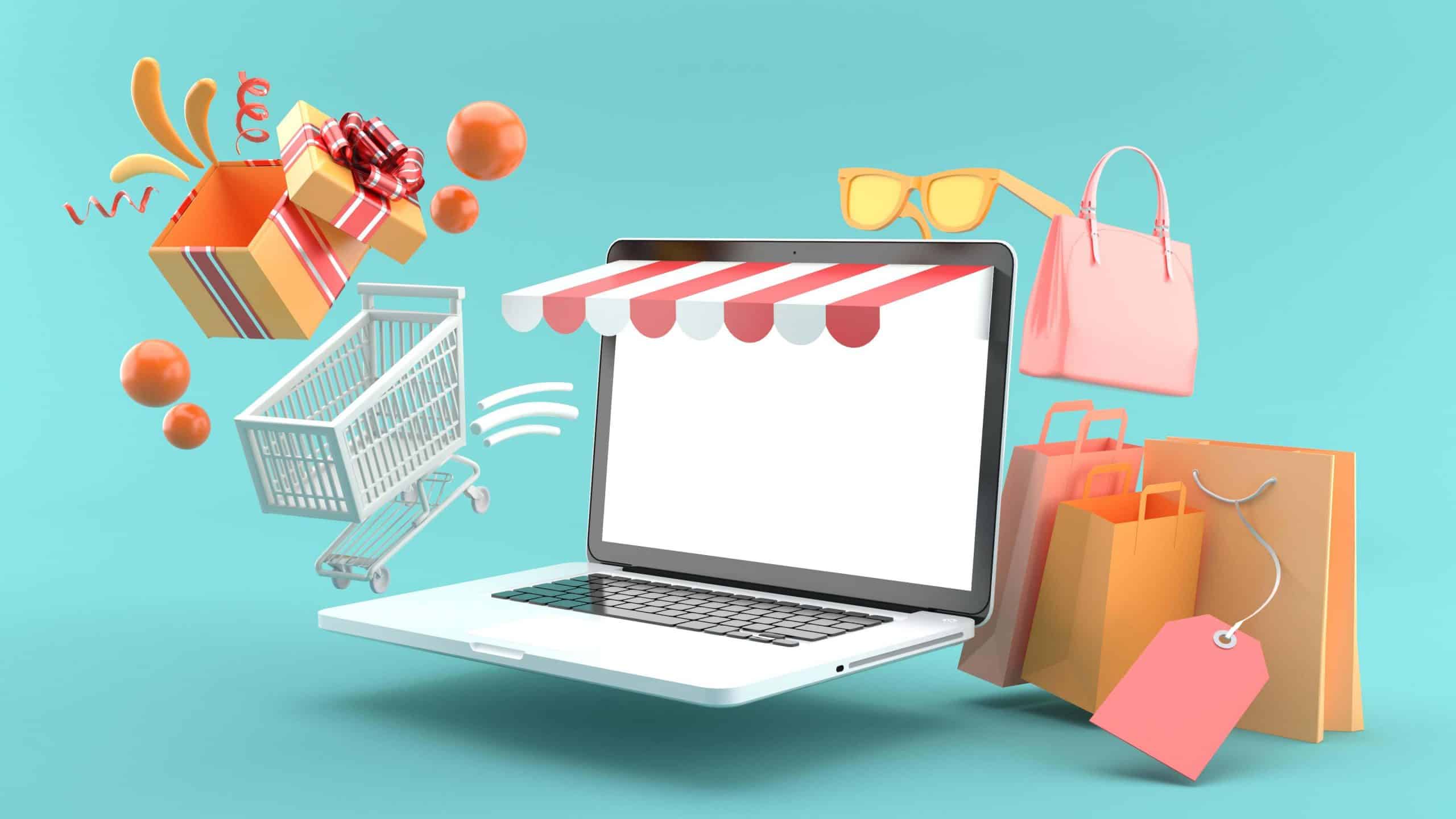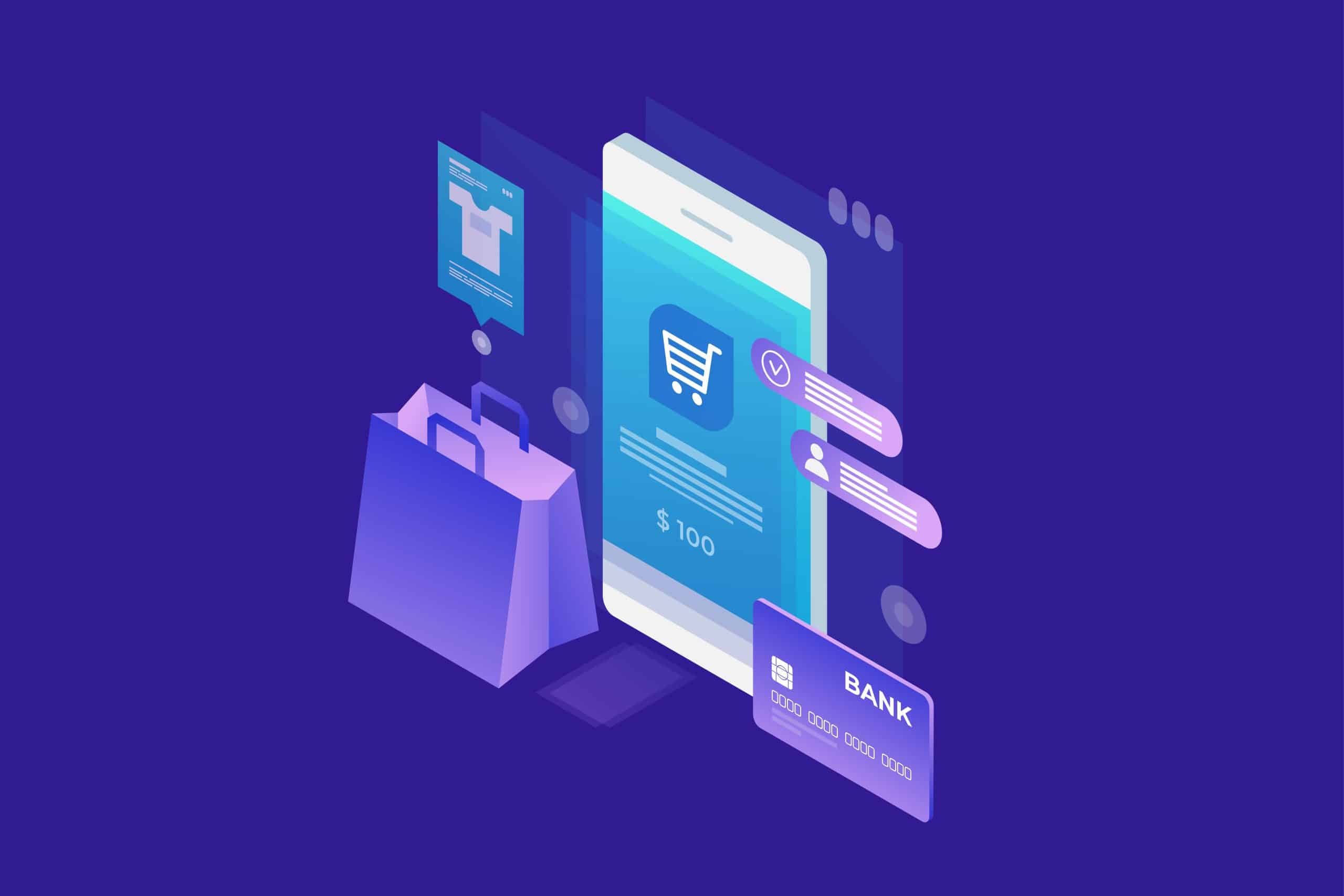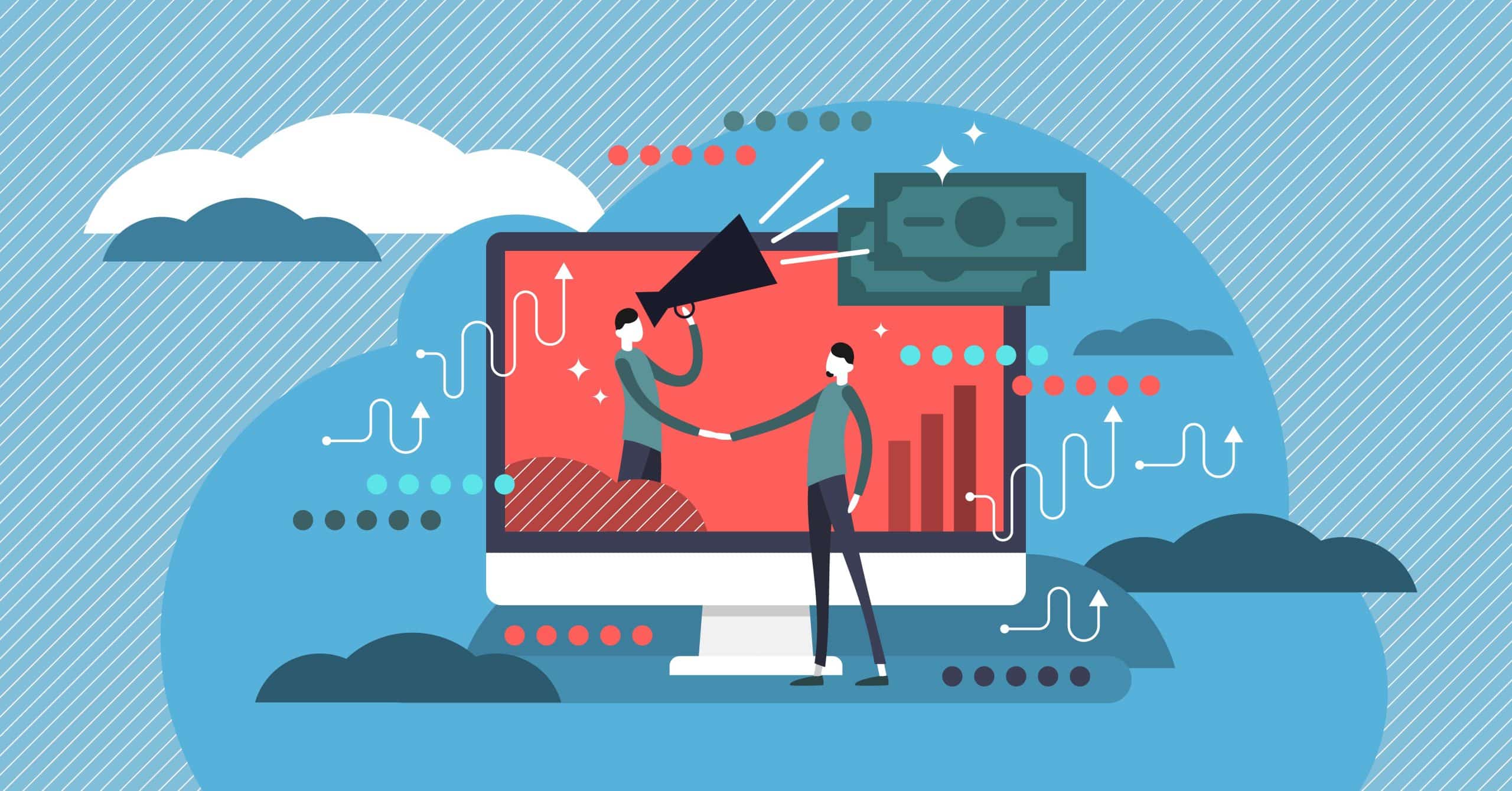
Whether you’re an avid Amazon Prime shopper or an ASOS new in browser, an eBay scourer or an Etsy fiend, the world of e-commerce is familiar to us all (nearly). The past two years have seen the E-commerce industry grow consistently – it’s set to comprise nearly 25% of total global retail sales by 2025, with sales of 7.4 trillion US dollars in that year alone. With sales that staggering, there’s no going back, right? Especially as our digital-first world continues to evolve.
E-commerce provides countless more opportunities for growth over traditional commerce given the lack of physical boundaries an online store holds. It can make your audience span geos, lifestyles, cultures, ages, and many other demographics. It can help you fine tune your targeting and expand your conversions through specific digital marketing strategies that work in tandem with your e-store front. In summary, your business needs to hop aboard the E-commerce marketing bandwagon to avoid being left in the past. Keep reading to find out the best way to go about it.

What is E-Commerce Marketing?
E-commerce marketing is the method of driving traffic to online stores by converting visitors into customers, as well as retaining those customers after their purchases. Popular tools used within E-commerce marketing include social media, SEO content, search engine ads, email campaigns and more. E-commerce marketing strategies must incorporate a variety of KPIs from brand awareness to brand loyalty.
Are you in need of a Digital Marketing Agency?
Our digital marketing experts are here to help you achieve success.
Changes in E-Commerce Marketing
Google is in the process of phasing out third-party cookies in Google Chrome. Considering that Google Chrome is the most popular web browser in the US, holding 48.6% of US browser market share as of January 2022, the impact of this phaseout is hugely significant. Marketers have consistently relied on cookies to track users for years. However, this reliance will have to shift towards collecting first-party data instead. Paid ad campaigns, especially remarketing and retargeting campaigns, can no longer rely on third-party data.
If the solution is first-party data, what does this entail? First-party data could be an email list, for example. Marketers will now have to focus their attention on growing email lists, such as by incentivizing consumers with promotional offers, discount codes, exclusive content, valuable content and general rewards when they opt into your subscriber list.

E-commerce Marketing Tools & Platforms
- Oracle Bronto is a cloud-based commerce marketing automation platform that helps mid-market and enterprise businesses.
- SharpSpring is an end-to-end sales, marketing automation, and CRM revenue growth platform that helps both agencies and businesses.
- Hunch is a market leading automation platform that uses data-driven creative performance workflows and automated media buying processes to help global brands grow their revenue and increase efficiency.
- EngageBay is a CRM platform with marketing, sales and support solutions that helps growing businesses to engage and convert their web visitors into satisfied customers.
- BigCommerce is an e-commerce platform that provides software and services to retailers (small to enterprise), including online store creation, search engine optimization, hosting, and marketing and security.
- DataFeedWatch is a feed marketing solution that combines data transformation with help and advice to empower merchants and agencies in their e-commerce processes.
- Justuno is a platform that leverages first-party data to bring the maximum return on ad spend (ROAS) possible with a smooth and personalized experience for business subscribers.
- Elementor is a software company that provides web development services allowing WordPress users to create and edit websites.
- HotJar is a tool that shows website heatmaps and behavior analytics to businesses to give insights into user needs.
- CrazyEgg is a website optimization tool that provides heatmaps and A/B testing to see what’s proving successful on a website and what’s not.
- Square Online allows businesses to build online stores and e-commerce sites.
- Shopify is an e-commerce platform for online stores and retail point-of-sale systems that helps millions of brands globally.
- Salesforce Commerce Cloud connects commerce to service, marketing and sales channels.
- Adobe Commerce (was Magento) is an e-commerce branch of Adobe that helps businesses improve digital commerce shopping experiences with multiple features.
- Oracle CX Commerce is a cloud-native SaaS commerce solution that supports B2C and B2B models in one platform.

E-Commerce Marketing Benefits
The benefits of e-commerce marketing are plentiful. Online shopping has grown impressively over the last few years, in large part due to the convenience and boosted by the pandemic in the past few years. It’s helped businesses grow their profits. We’ve listed a number of benefits that highlight why E-Commerce and E-Commerce marketing is great for businesses.
Speedy Process
We’ve all purchased something online at some point. We know how easy it is. It takes just a few clicks to buy a product online. By removing as much friction and time from the process, E-Commerce marketing helps to increase the likelihood of consumers making purchases. A big part of E-Commerce marketing is the optimization of the sales funnel to help consumers reach the purchase stage as simply, efficiently and engagingly as possible.

Display Products As You Like
Product listings offer ways to display products how you want them to be seen with product descriptions, engaging photography, design, matched with other products, etc. Everything is customizable to make the product as attractive as it can be to potential customers.
Cost Effectiveness
E-commerce websites can be cheap to host, as low as $20 a month, and are certainly much cheaper than physical stores. As a result, more money and be dedicated to marketing budgets to drive people to your E-Commerce store.
Flexibility
E-commerce shops are available 24/7 and are not confined to the same restrictions as physical shops, whether that is opening times, location, space, etc. That provides more opportunities for sales to be made. People can access online stores from anywhere, opening up your products to a wider national or global audience.

Targeting
E-commerce stores can target a wide range of demographics from different age groups to consumers in different countries. Targeting can be done within PPC campaigns, social media ads and sponsored posts, etc.
Are you in need of a Digital Marketing Agency?
Our digital marketing experts are here to help you achieve success.
E-Commerce Marketing Strategy Guide
1. Establish KPIs
Outlining your goals and KPIs before you begin any marketing process is essential, so e-commerce marketing is no different. Examples of ecommerce KPIs are:
- Grow sales by x% YoY
- Increase conversion rate by x% in 2022
- Grow ROI by x% in 2022
2. Define Target Audience
Again, this is essential when beginning any marketing campaign. Who are you trying to reach with the campaign? Ask yourself who your target consumer is, how old they are, where they live, what their interests are, what inspires them, what their purchasing power is and more. The answers to all of these questions will inform how you market your product, including which geos to market it in, the price it will have success at, the branding style that will resonate with consumers and more.

3. Competitive Analysis
Keeping an eye on your competitors can inform your own strategy by seeing what’s working for them and what’s not, what’s popular within your niche, and how you can get ahead of them. Conducting an effective competitive analysis comes with many guidelines we’ve previously outlined in this blog.
4. Establish Pricing
Once you’ve conducted a competitive analysis and established your target consumers, you’ll have an idea of the price points that your competitors are using and which will best suit your own target consumers. It’s important to do your research to not risk pricing your product(s) too high that it will isolate your target consumers, or too low that you’re making less profit than you should be.
5. Test
As with every marketing campaign, testing plays a prominent role. You’ll never be able to measure the true success of your sales funnel strategies and campaigns without testing them. It’s an essential step in order to move forward with the best chances of success.

Types of E-Commerce Marketing
Social Media Marketing
Social media is the perfect platform for showcasing products in the places where people hang out the most. The average American spends more than 1,300 hours on social media in a year – that gives you a lot of time to put your products in front of them.
Building an attractive social media page with valuable content that helps you grow a loyal following and displays your products in the best light is the way to go.
Establishing your own branding and maintaining that common thread across all of your posts is a great way to make your content instantly recognizable and associated with your products.
Posting frequently and consistently is another essential way to put your products at the forefront of potential customers’ minds. If they see your content enough times on social media, when they hit a pain point that your product solves, you’ll likely spring to their mind.
Also, the more valuable your content is, the more it will remove any reservations that may prevent consumers from becoming your customers. If you’re a fashion ecommerce retailer, showing your clothes styled on real people could encourage users to buy those products by helping them understand how to wear them, inspiring them to style them creatively, how oversized or fitted they run, etc. If you sell stationery, showing different ways to optimize your life using your stationery can be another way to inspire people to make the purchase.
Social Media Advertising (Paid Ads)
Beyond building your own social media page, brands can see impressive growth from pushing ads on social media to targeted audiences. Whether that’s boosting pre-existing posts to wider audiences (that can be segmented according to different factors such as age, geo, interactivity, etc) or publishing new dark posts that appear as sponsored content on people’s feeds but don’t appear on your social media page.
Advertising on social media allows you to put your products in front of new people that haven’t necessarily come across your page before, but fall into the category of your target customers. Our Media Buying team can help should you require more information.
Influencer Marketing
The world of influencer marketing has taken off in the last few years. Whereas previously it may have been considered a more fringe marketing method, it’s now well and truly at the forefront. Influencers are one of the most powerful tools marketers can use because consumers build up a relationship with them and trust them more than brands themselves.
What is influencer marketing? Good question. It’s a way of using influencers to promote your product(s) that can involve various methods, from gifting them your product in exchange for a content feature to sponsoring social media posts. There are different types of influencers that have different pros and cons. Macro influencers have the biggest following, but that doesn’t mean they’re more effective at promoting your product since micro influencers tend to have stronger engagement and trust from their following. Here is more information on how to build the right influencer marketing campaign for apps.

Social Commerce
Globally, the social commerce industry is set to grow three times as fast as the traditional e-commerce industry itself. Gen Z and millennial consumers will be the drivers of this growth since they will begin to comprise the majority of social commerce spend. Social commerce is expected to grow from 10% of all e-commerce to 17% by 2023.
Backtracking a little, social commerce is a branch of e-commerce where social media platforms facilitate or contribute to the selling of products and services.
Email Marketing
Email marketing is incredibly important in the broader e-commerce marketing funnel. How often do you make a purchase online and not receive a follow-up email? Or emails to indicate delivery progress? Never, right? That’s because post-purchase emails are an absolute essential within e-commerce. They not only provide the customer with written confirmation and details of their purchase, they also help build a relationship between the customer and the brand.
Abandoned shopping cart emails are particularly popular in e-commerce marketing because they give the consumer a gentle nudge to complete a purchase they previously were so close to. Perhaps the consumer just got distracted and a helpful reminder is exactly what they needed to follow through.

Content Marketing
This can encapsulate many of the other marketing methods already mentioned, such as social media and email marketing, given that both of those require the production of content. However, content marketing is less specific and includes both of those content forms in addition to many others. It’s a type of inbound marketing that helps bring the consumer to your business without you having to go and seek them, with a big focus on SEO.
Content marketing is centered around the creation, publication and distribution of content, such as videos, blogs and articles, for an online audience. Most commonly, this content does not explicitly promote a particular brand or its products, instead providing value on topics relating to the brand or its products to pique the interest of the audience.
Product Page Optimization
Marketing revolves around a variety of different optimization forms, this being no different. There’s App Store Optimization, Search Engine Optimization, Conversion Rate Optimization and more, so Product Page Optimization doesn’t stand alone. We’re big fans of optimizing everything here at Moburst. Since e-commerce relies on online storefronts, optimizing these pages to improve their SEO value and the entire customer experience is essential for increasing conversions and exposure.
Product page optimization has to focus on both the verticals of SEO and user experience, because it must help consumers find the page within search engines as well as encourage the likelihood of them converting once they reach the page. Product pages should be optimized towards conversions, with the sales funnel kept as seamless and streamlined as possible.
An optimized product page will have multiple high-quality images showcasing products, relevant keywords in product titles and descriptions, customer reviews, a clear and simple design, and strong branding in line with the rest of the site. All of these elements will be looked upon favorably by Google and by customers who reach your page.
Search Engine Marketing
This is a subset of marketing commonly used for e-commerce businesses because its ultimate aim is website promotion. Websites are promoted by increasing their visibility in the search engine results pages (SERP) through the use of paid ads. Search engine optimization, the organic side, involves optimizing web pages according to different ranking factors that will help the search engine algorithms rank it higher.
Examples of search engine marketing are pay-per-click campaigns and Google Shopping campaigns.
Affiliate Marketing
This is a performance-based marketing method in which businesses take on affiliates who will be rewarded for each site visitor or customer who comes via their specific links or promotions. It’s used often for e-commerce sites as a way to drive more traffic and potential customers to their sites and promote their products.
It’s also considered a form of influencer marketing due to the popularity of using influencers as affiliates so that they can attach affiliate links to the products they’re displaying within their content.

Are you in need of a Digital Marketing Agency?
Our digital marketing experts are here to help you achieve success.
FAQs
It’s the process of driving traffic to online stores by converting visitors into customers and retaining them after their purchases.
Popular E-Commerce tools and platforms include BigCommerce, Shopify, Oracle Bronto, Adobe Commerce, CrazyEgg and Hunch, among many others.
A successful E-Commerce marketing strategy consists of establishing your KPIs, defining your target audience, conducting a competitive analysis, establishing pricing and testing.
There are many benefits of E-Commerce marketing, including the speed of the process, the ability to display products however you like, cost effectiveness, flexibility and the opportunity for targeting.






